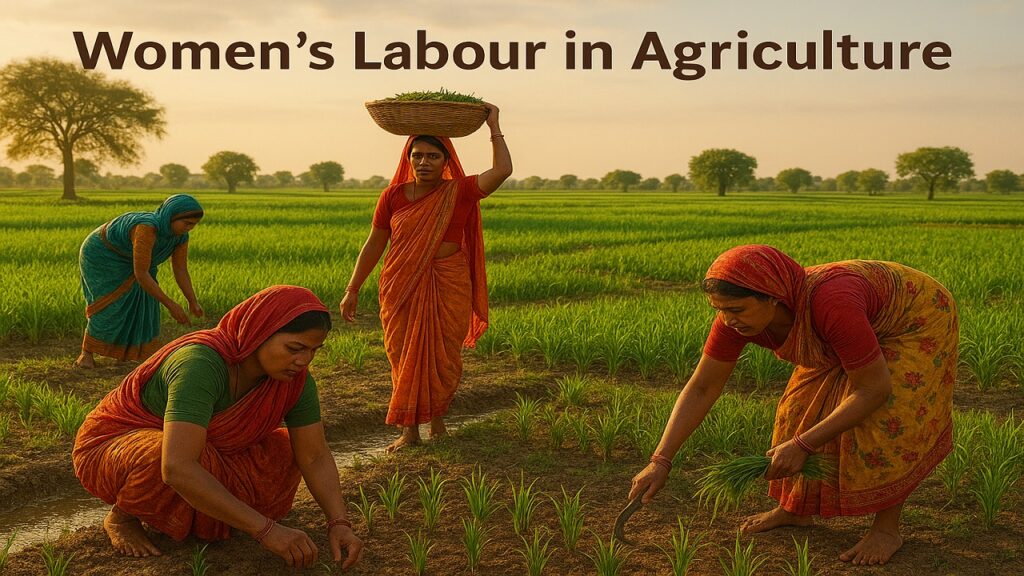Women’s Labour in Agriculture: From Unpaid Work to Economic Inclusion
Context

- Agriculture is the largest employer of women in India, yet a significant portion of women work without remuneration, reflecting persistent gender inequities.
- With increasing participation of women, there is a pressing need to recognise their contributions, address challenges, and enhance their economic empowerment in agriculture.
1. Status of Agriculture Sector in India
- Global Leadership: India ranks among the top producers of milk, pulses, spices, fruits, vegetables, and sugarcane, and has the world’s largest area under wheat, rice, and cotton.
- Robust Growth: In 2025, India’s agricultural sector recorded 3.7% growth in Q1, supported by increased production and strong export performance.
- Foodgrain Production: Estimated at 347.44 million tonnes in 2024–25, showing steady growth.
- Agricultural Exports: 5.8% year-on-year rise in Q1 of 2025–26, demonstrating India’s growing global footprint.
- Women’s Employment:
- Women now form over 42% of the agricultural workforce.
- PLFS 2024 reports two-thirds of working women are in agriculture.
- 2011 Census: 3.6 crore women farmers and 6.15 crore women agricultural labourers, with 80% of rural women engaged in agriculture.
2. Challenges Faced by Women in Agriculture
- Lack of Recognition: Women are rarely officially recognised as farmers, unlike men.
- Fluctuating Roles: With male outmigration due to climate stress, low farm returns, and industrial opportunities, women increasingly manage farms, livestock, and household food systems.
- Diverse Responsibilities: Women act as cultivators, entrepreneurs, labourers, and managers of allied sectors like dairy, horticulture, and forestry.
- Feminisation of Agriculture: Increasing women’s participation has not necessarily improved income or empowerment.
- Limited Land Ownership: Women own only 13–14% of land holdings, earning 20–30% less than men for equivalent work.
- Unpaid Family Work:
- Nearly half of women in agriculture are unpaid family workers.
- Numbers increased 2.5 times from 23.6 million to 59.1 million in 8 years.
- In Bihar and Uttar Pradesh, 80% of women work in agriculture, with over half unpaid.
- Economic Inequities: Despite higher participation, agriculture’s share in national GVA declined from 15.3% (2017–18) to 14.4% (2024–25).
- Resource and Technology Gaps: Women often lack training, access to technology, digital literacy, affordable devices, and financial support.
3. Measures to Enhance Women’s Employment in Agriculture
- Collective Action: Requires efforts by government, private sector, NGOs, self-help groups, and FPOs.
- Global Recognition: UNGA declared 2026 as International Year of the Woman Farmer.
- Export-Led Opportunities:
- Women can shift from low-value, unpaid tasks to processing, packaging, branding, and exports.
- FTAs like the India–U.K. FTA may boost exports by 20% in 3 years, with duty-free access to 95% of agricultural and processed products.
- Premium Product Markets: Geographical Indications, branding, and compliance with export standards help women transition to value-added agriculture, particularly in organic and superfood sectors.
- Digital Innovations: Tools like e-NAM, mobile-based services, voice-assisted apps, and precision agriculture tools formalise women’s labour and expand access to credit, schemes, and fair pricing.
- AI Solutions: Platforms like BHASHINI and Microsoft AI4Bharat’s Jugalbandi provide multilingual, voice-first access to government services.
- State Initiatives:
- Odisha’s Swayam Sampurna FPOs
- Jhalawari Mahila Kisan Producer Company, Rajasthan
- Women farmer training programs in Assam’s tea sector
Support women in export competitiveness and leadership roles.
Conclusion
- Land and Labour Reforms: Policies must recognise women as independent farmers, promoting joint or individual land ownership to enhance access to credit, insurance, and institutional support.
- Formal Recognition and Economic Inclusion: Linking women’s work to formal systems through digital tools, training, and market access can transform unpaid roles into sustainable, income-generating livelihoods.
- Way Forward: Comprehensive reforms, technological inclusion, and policy interventions are critical for economic empowerment and gender equity in agriculture, ensuring women are active contributors to India’s food security and export potential.
Source : The Hindu
